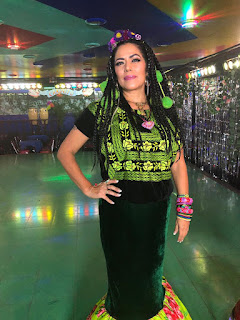Lila Downs - Live at Old Town School
The Chicago World Music Festival was a stunning success in its inaugural year: attendance surpassed the organizers' expectations, and the logistical difficulties of bringing in 40-some acts from around the globe to play a ten-day event with 12 different venues were largely invisible to the public. Most important, the quality and diversity of the music immediately established the fest as one of the premier musical events in the country.
This year the festival, which began on September 21, includes one more day and about ten more acts. A rather impressive 16 are making their Chicago debuts, and another four are performing for the first time in the United States. Once again the scope of the programming is promisingly broad, ranging from a night of hip-this-minute international electronica to a very rare performance of Korean shamanist music.
All the events are free and open to fans of all ages unless otherwise noted; $10 is the maximum ticket price, except for the closing-night concert by Chava Alberstein and Susana Baca at Symphony Center. In most cases advance tickets are available from the venues, and those wanting a preview can pick up an inexpensive ten-song sampler, issued by Big Chicago Records, at local record stores. A number of the musicians will give lunchtime concerts in the studio at the Museum of Broadcast Communications; these will be broadcast live on Continental Drift, the world-music show on Northwestern University's radio station, WNUR (89.3 FM).
One more thing: for those interested in talking as well as listening, there's a free panel discussion about the tension between traditionalism and fusion in world music. It takes place Friday, September 29, at noon in the Cultural Center's Claudia Cassidy Theater. The panelists are Amon Tobin, saxophonist Trevor Watts, Fethi Tabet of Comifo, Latin-jazz pianist Danilo Perez, festival organizer Michael Orlove, moderator Ben Harbert from the Old Town School of Folk Music, and yours truly. --Peter Margasak
Lila Downs
Born in Oaxaca to a Mixtec mother and an Anglo-American father, Lila Downs was raised in both Mexico and the U.S., and not surprisingly she grew up obsessed with cultural identity. After studying music and anthropology at the University of Minnesota, she went from bleaching her hair blond to wearing traditional Mixtec garb--she now resembles Frida Kahlo, with her jet black braids and colorful embroidered blouses--and began performing her beguiling blend of traditional Mexican music and North American jazz and pop. So thoroughly does she inhabit whatever form she's singing--be it a bolero, a smoky ballad, or a Mixtec folk song--that it's tough to distinguish between the traditional material and her originals on her new album, Tree of Life (Narada World). In some ways her work parallels that of Peruvian singer and musicologist Susana Baca (see October 1 entry), and though her voice isn't as strong as Baca's, she does more with it.
08. Nueve Viento - Lila Downs 4:40
09. Ofrenda - Lila Downs 3:06
FUENTE




Comentarios
Publicar un comentario